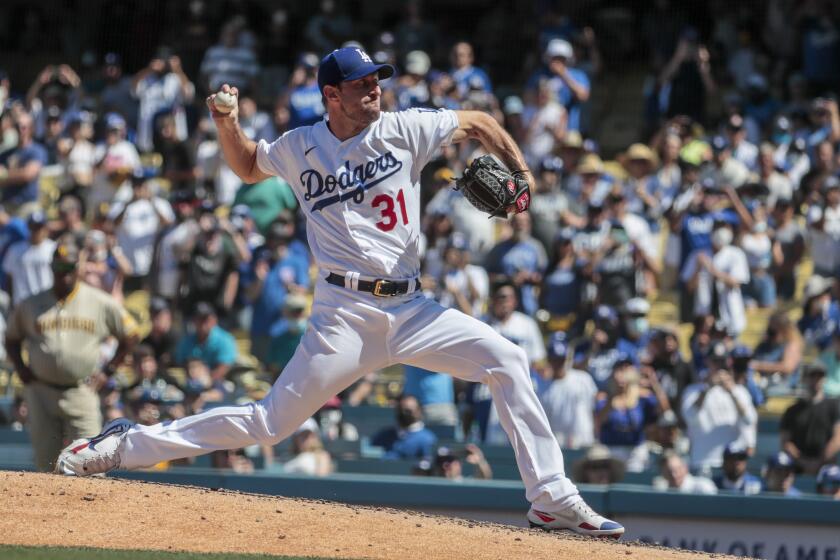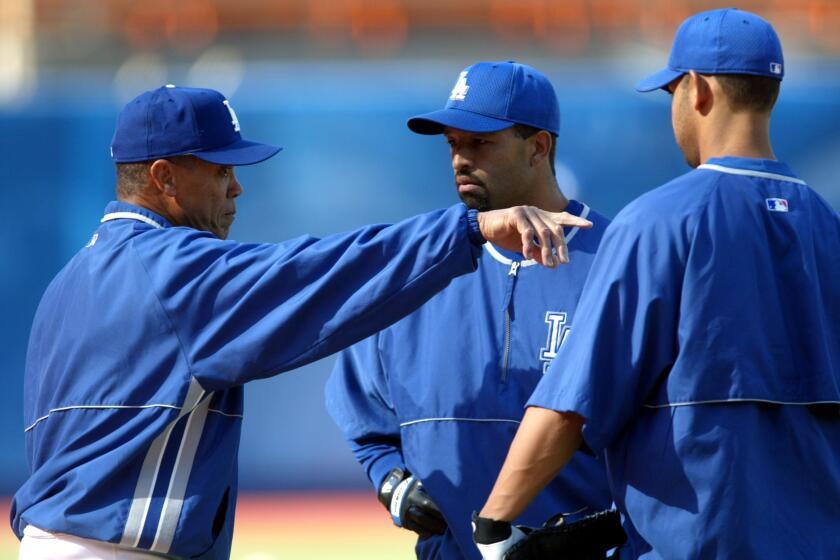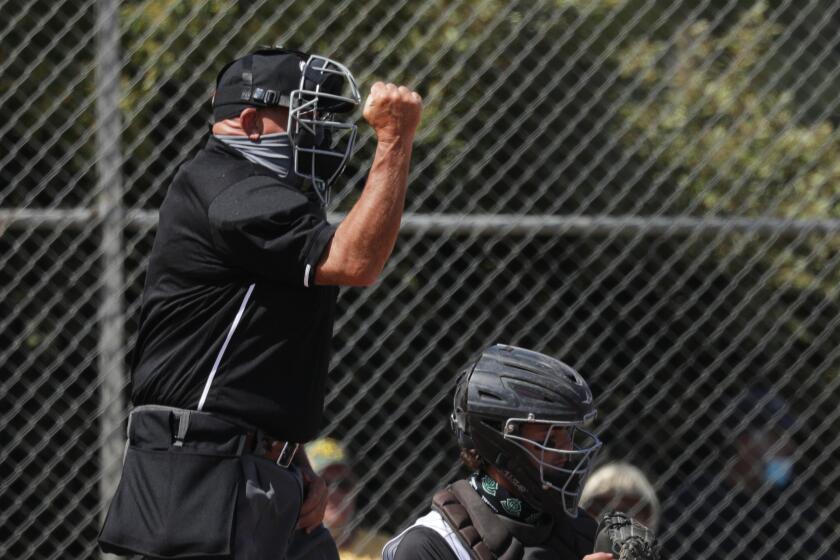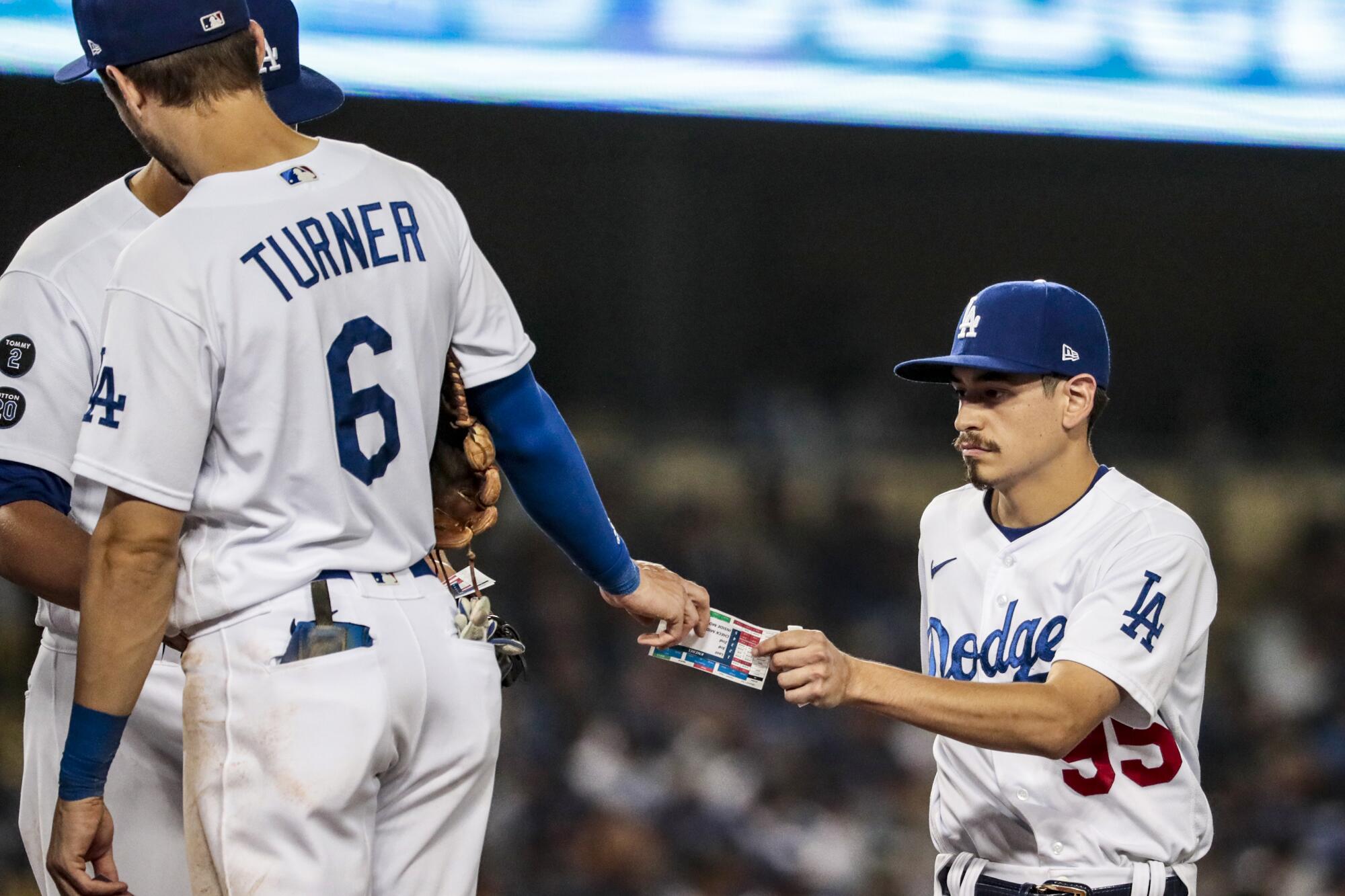
- Share via
Dodgers manager Dave Roberts calls timeout and makes a beeline to the pitcher’s mound. He takes the ball and signals to the bullpen.
That’s the cue for the bat boy to race to the mound where infielders have congregated and hand cards to Corey Seager, Trea Turner, Max Muncy and Justin Turner, all of whom tower over his short, lithe frame. Next the bat boy is sprinting to deep center field where Chris Taylor, Cody Bellinger and Mookie Betts await.

Fernandomania @ 40
Join us for the in-person 'Fernandomania @ 40' Finale event
We invite you to the exclusive finale celebration of ‘Fernandomania @ 40,’ our multi-episode documentary series that examines Fernando Valenzuela’s impact on the Dodgers, Major League Baseball and the Latino community in Los Angeles.
Join us Monday, Oct. 4 at the Montalbán Theater in Hollywood for screenings, and discussions with the stars of the documentary, including Ray Lara, Gloria Molina, Richard Montoya and Jaime Jarrín
Buy your tickets here.
ESPN Deportes is the sponsor for this event.
He hands the outfielders cards and dashes toward the left-field line. Once in foul territory, he slows to a jog and waves to fans calling his name.
The cards inform fielders where to position themselves given the new pitcher and hitters he’ll face. Delivering them was added to a bat boy’s tasks in this era of advanced analytics and defensive shifts, and can become a full-blown cardio workout when pitching changes are frequent.
Fans above field level might wonder how the kid will have enough energy later to finish his homework.
Those sitting near the field, however, can make out a black goatee and pencil mustache. They can tell that, in fact, the bat boy is a bat man.
Since joining the Dodgers at the trade deadline, Max Scherzer is 7-0 with an ERA of 0.78. The clubhouse culture, he says, has made it easy to fit in.
::
Branden Vandal, 25, sits in the Dodgers dugout a couple hours before a recent game stroking that goatee and counting his blessings. He holds a bachelor’s degree in business management, but he’s not ready to wear a suit and tie.
He’s having too much fun wearing a Dodgers uniform with number 95 stitched on the back underneath BRANDEN. That’s the way bat boys roll — first names only and numbers in the 90s — in constant motion from several hours before games until several hours afterward.
“I think at first fans see a bat boy and assume it’s a younger kid,” said Vandal, who is 5-feet-6 and 140 pounds. “But all these guys are young men or older, even in their 30s. We do it because we enjoy what we do.
“It’s a great gig to be this close to big league baseball every day.”
Apparently, it’s so wonderful that nobody seems to leave, at least not with the Dodgers. Vandal has been a bat boy since 2015, and seven of the other eight Dodgers bat boys and clubhouse attendants — known as clubbies — are senior to him. Bat boys generally aspire to become clubbies because the pay is better.

“I think at first fans see a bat boy and assume it’s a younger kid. But all these guys are young men or older, even in their 30s. We do it because we enjoy what we do.”
— Dodgers bat boy Branden Vandal
Additional attendants work the visitor’s clubhouse, including Mitch Poole, who also spent 32 years in the Dodgers clubhouse. The longest-tenured is Jerry Turner, hired as a Dodgers bat boy in 1979 and the visitor’s clubbie for 25 years. He now serves as the umpires’ locker room manager.
Dodgers clubhouse manager Alex Torres, 42, started as a bat boy in September 1996, landing the job because his next-door neighbor was a bat boy and the team needed an extra hand during the stretch run. Now the bat boys and clubbies report to him and assistant manager Jose “Peps” Castillo, who like Vandal has a B.A. — in criminal justice from Cal State L.A.
“I haven’t had to interview anyone new,” Torres said. “Branden is the only hire I’ve made. It says a lot about the kind of people and workers they are to be together this long. I’m blessed.”
Dodger legend Maury Wills answers some questions posed by newsletter readers.
Players appreciate the continuity. Outfielder Matt Kemp paid for flights to Phoenix and hotel rooms for five veteran bat boys and clubbies in September 2013 so they could be present if the Dodgers clinched the NL West against the Diamondbacks (they didn’t).
All five — Gabriel Esparza-Torres, Chico Herrera, Sergio Garcia, Javier Herrera and Eddie Gonshorowski — are still with the Dodgers. And all five, along with their workmates, received 2020 World Series championship rings.
::
Bat boys make little more than the minimum wage but are the envy of anyone who dreams of holding a job that puts them in uniform, on the field, in the dugout. Labor laws can vary but the Dodgers won’t hire a bat boy younger than 18 because of clubhouse duties and potential travel.
Gonshorowski, 33, Javier Herrera, 35, and Vandal are the current bat boys. Two work each game, with the other helping Torres’ clubhouse team do laundry, scrape mud off cleats, tidy up locker space and anything else necessary for players to focus on performing on the field.
The trio doesn’t exactly rotate roles because when the Dodgers win, the same two bat boys return to the dugout the next day. It’s a superstition not unlike a player wearing the same socks every day during a hitting streak.
Vandal’s on-field tasks begin leisurely enough. He stands next to a bucket behind a protective screen in shallow center field during batting practice, his back to home plate. When a player shags a ball in the outfield, he tosses it to Vandal.
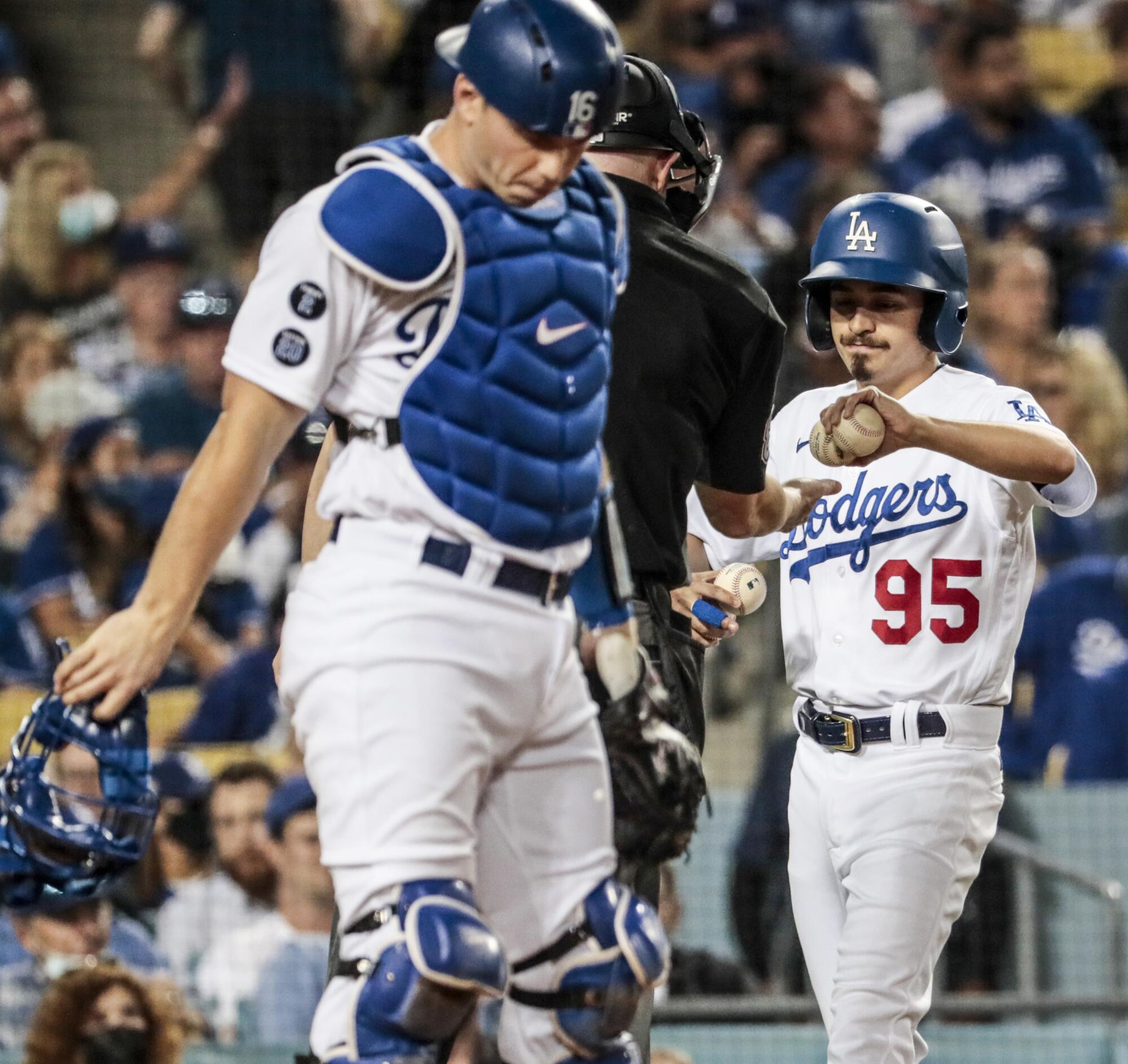
The game begins, and Vandal doesn’t stop moving. He supplies the umpire with new baseballs, about 150 per game. He pops out of the dugout to snag used balls rolled to him by the umpire or catcher, then skips back down the dugout steps and flips them into a bucket.
Vandal places a weighted bat, pine tar rag and rosin bag in the on-deck circle for Dodgers hitters at the beginning of each inning. When the ball is hit, he performs the duty most fans associate with a bat boy, hustling to home plate to retrieve the bat. When a bat breaks, he collects the shards.
Batters reach base, unstrap the protective armor guarding their shins and elbows, and hand them to — who else? — Vandal.
Then come pitching changes. A rule implemented two years ago to speed up the game requires a relief pitcher to face three batters before he can be replaced.
Consider Vandal eternally grateful for the rule. It enables him to catch his breath before grabbing the proper positioning cards from a binder and dashing onto the field again.
“Once in Arizona, Gavin Lux had the wrong card,” Vandal said. “Between pitches I had to run out to shortstop and give him the right card. He might have been three steps in the wrong direction without it.”
::
Bat boys, clubbies and their ball boy and ball girl brethren are support staff, like rock-n-roll roadies or key grips on a movie set. But in an age of cell phone cameras and social media, sometimes they’re stars.
Just ask Javier Herrera, Chico Herrera, or Marissa Rohan.
“You’d think being together every day, all day, we’d get tired of each other’s company, but no. We just get along.”
— Dodgers clubhouse attendant Gabriel Esparza-Torres
Javier Herrera’s 17 years of anonymous employment with the Dodgers was interrupted by one selfless act in 2015. The ball girl normally stationed in a chair down the left-field line charged with fielding foul balls didn’t show up, so Herrera, then a bat boy, filled in.
The game was uneventful until the fifth inning when a pop fly sailed toward Herrera. He stood, lifted his glove and leaned back so far he tumbled over the railing, over a tabletop and landed headfirst on the concrete floor.
The ball bounded into the stands.
“I lay there thinking, ‘Oh my gosh, what did I just do? I just embarrassed myself on national TV!’” he told The Times’ Bill Plaschke.
Herrera collected himself, climbed back over the railing and sat down. He expected fans to ridicule him. They gave him a standing ovation.
“I think the fans kind of feel like he was them,” Poole said.
Another everyman episode fans loved were the heroics of Chico Herrera (no relation to Javier), a Dodgers clubhouse attendant of 13 years, during training camp before last year’s abbreviated season.
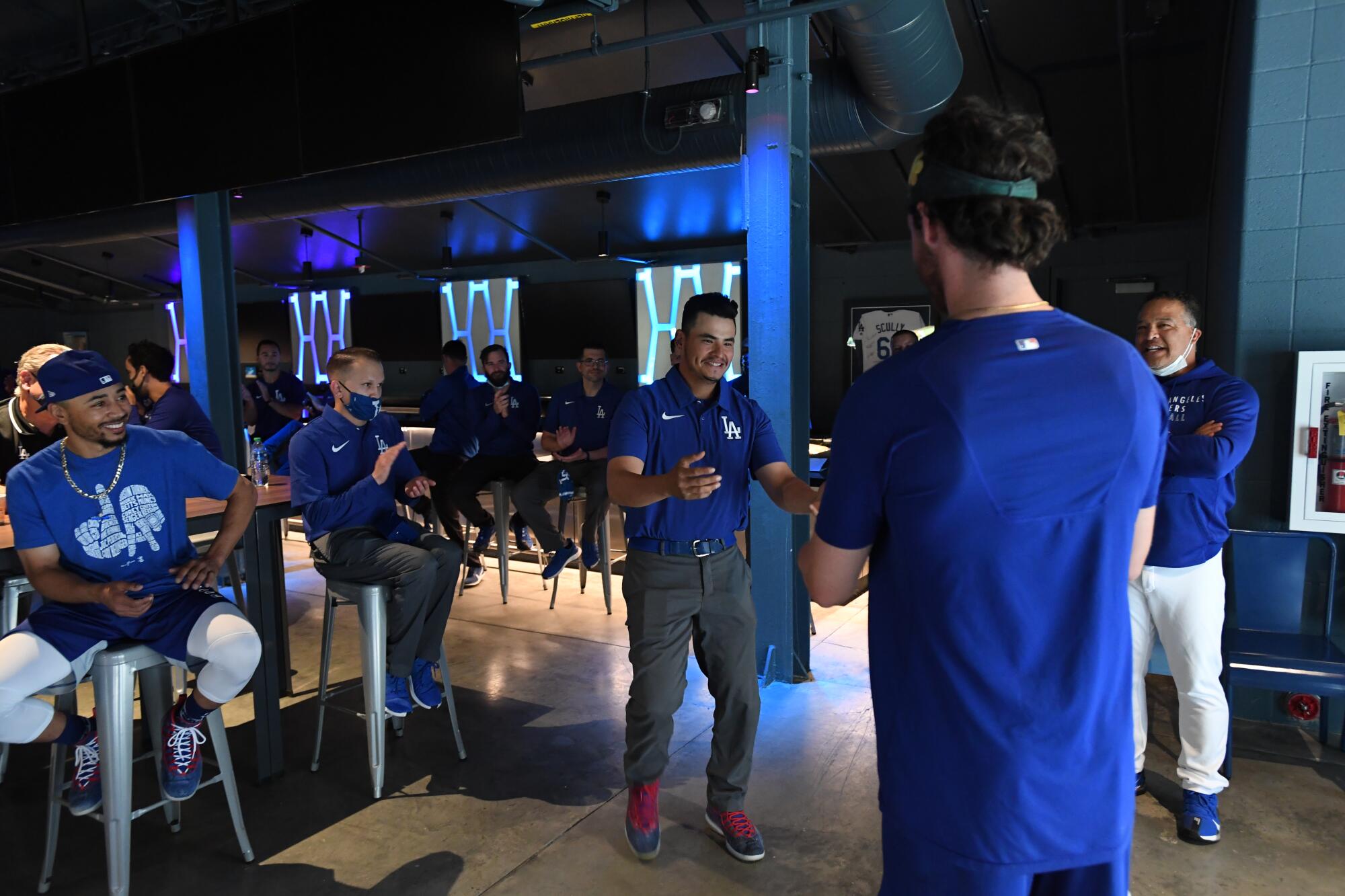
The Dodgers were short players for intrasquad games, so Herrera, 31, grabbed a glove and ran out to left field. Chris Taylor tagged up from first base on a fly ball to Herrera and headed to second. The clubhouse attendant threw him out.
In another game, Herrera made an acrobatic catch at the warning track and doubled up a runner returning to first base with a strong throw.
Soon Herrera was featured in the Times and on MLB Network. But just as quickly, he was back in the clubhouse, washing the clothes and scrubbing the batting helmets.
The most recent viral moment came a month ago from Marissa Rohan, a 24-year-old Cal State Northridge senior who serves as the Dodgers ball girl seated down the right-field line.
A fan running across the outfield eluded several security guards, but not the ball girl. She lunged and knocked him off-balance. He tumbled over the railing and was quickly apprehended while fans cheered Rohan. Video was uploaded on Twitter within minutes.
Los Angeles Times assistant sports editor Steve Henson shares inside info from his side hustle as an umpire at high school baseball games.
She didn’t mind the attention, writing on Instagram: “Yeah I am not going to stop talking about this lol.”
“DON’T MESS with the BALL GIRL” T-shirts soon were available.
::
Bat boys relish the ballgames. That’s obvious. But what’s the worst part of the job?
“Unpacking,” Torres said. “Across the board, every clubhouse person, it’s what you don’t look forward to.”
The Dodgers finished a trip in August with an evening game in New York against the Mets. They arrived in Los Angeles at 3 a.m. The players went straight home to get some sleep ahead of their home game Monday night against the Pittsburgh Pirates.
The bat boys and clubbies worked until daybreak, unpacking every equipment bag, washing every uniform, stitching every tear, and cleaning every cleat and helmet.
They got home bleary-eyed and set their alarms for noon.
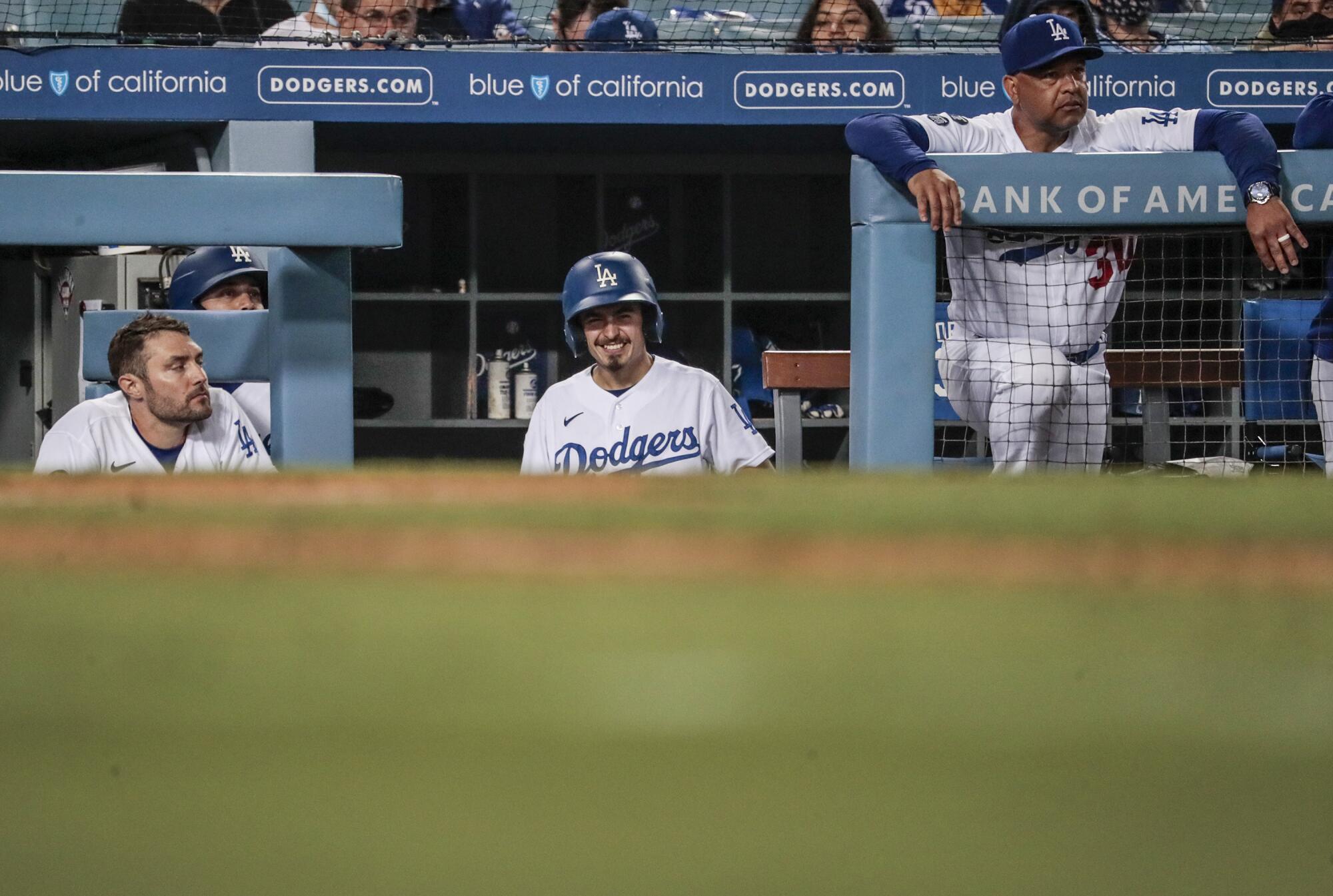
Every clubbie and bat boy except Vandal and R.J. Peete — son of former USC and NFL quarterback Rodney Peete — is married or engaged. They have lives away from Dodger Stadium, but they love the vocation they’ve chosen.
“We are all a family,” Torres said. “We know each other so well. We hang out together. You’d think being together every day, all day, we’d get tired of each other’s company, but no. We just get along.”
The pandemic triggered a perk. For the first time, Dodgers bat boys and clubbies accompanied the team on trips the last two seasons to limit contact with employees of opposing teams. They stay in upscale hotels and get meal money, just like the players.
It’s a taste of the good life and Vandal, for one, aspires to advance beyond the dugout and clubhouse. He has his degree, after all. And consider an example from that team in Anaheim.
Angels general manager Perry Minasian started off as a bat boy.
More to Read
Go beyond the scoreboard
Get the latest on L.A.'s teams in the daily Sports Report newsletter.
You may occasionally receive promotional content from the Los Angeles Times.
